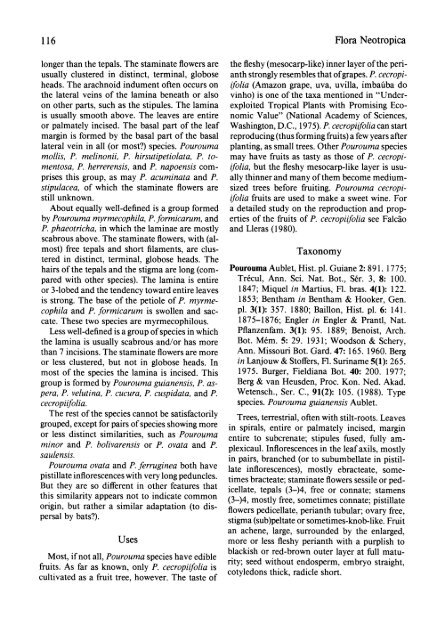Cecropiaceae: Coussapoa and Pourouma, with an ... - CNCFlora
Cecropiaceae: Coussapoa and Pourouma, with an ... - CNCFlora
Cecropiaceae: Coussapoa and Pourouma, with an ... - CNCFlora
You also want an ePaper? Increase the reach of your titles
YUMPU automatically turns print PDFs into web optimized ePapers that Google loves.
116 Flora Neotropica<br />
longer th<strong>an</strong> the tepals. The staminate flowers are the fleshy (mesocarp-like) inner layer of the periusually<br />
clustered in distinct, terminal, globose <strong>an</strong>th strongly resembles that ofgrapes. P. cecropiheads.<br />
The arachnoid indument often occurs on ifolia (Amazon grape, uva, uvilla, imbauiba do<br />
the lateral veins of the lamina beneath or also vinho) is one of the taxa mentioned in "Underon<br />
other parts, such as the stipules. The lamina exploited Tropical Pl<strong>an</strong>ts <strong>with</strong> Promising Ecois<br />
usually smooth above. The leaves are entire nomic Value" (National Academy of Sciences,<br />
or palmately incised. The basal part of the leaf Washington, D.C., 1975). P. cecropiifolia c<strong>an</strong> start<br />
margin is formed by the basal part of the basal reproducing (thus forming fruits) a few years after<br />
lateral vein in all (or most?) species. <strong>Pourouma</strong> pl<strong>an</strong>ting, as small trees. Other <strong>Pourouma</strong> species<br />
mollis, P. melinonii, P. hirsutipetiolata, P. to- may have fruits as tasty as those of P. cecropimentosa,<br />
P. herrerensis, <strong><strong>an</strong>d</strong> P. napoensis com- ifolia, but the fleshy mesocarp-like layer is usuprises<br />
this group, as may P. acuminata <strong><strong>an</strong>d</strong> P. ally thinner <strong><strong>an</strong>d</strong> m<strong>an</strong>y of them become mediumstipulacea,<br />
of which the staminate flowers are sized trees before fruiting. <strong>Pourouma</strong> cecropistill<br />
unknown.<br />
ifolia fruits are used to make a sweet wine. For<br />
About equally well-defined is a group formed a detailed study on the reproduction <strong><strong>an</strong>d</strong> propby<br />
<strong>Pourouma</strong> myrmecophila, P. formicarum, <strong><strong>an</strong>d</strong> erties of the fruits of P. cecropiifolia see Falcao<br />
P. phaeotricha, in which the laminae are mostly <strong><strong>an</strong>d</strong> Lleras (1980).<br />
scabrous above. The staminate flowers, <strong>with</strong> (almost)<br />
free tepals <strong><strong>an</strong>d</strong> short filaments, are clus-<br />
Taxonomy<br />
tered in distinct, terminal, globose heads. The<br />
hairs of the tepals <strong><strong>an</strong>d</strong> the stigma are long (com- <strong>Pourouma</strong> Aublet, Hist. pl. Gui<strong>an</strong>e 2: 891. 1775;<br />
pared <strong>with</strong> other species). The lamina is entire Tr6cul, Ann. Sci. Nat. Bot., Ser. 3, 8: 100.<br />
or 3-lobed <strong><strong>an</strong>d</strong> the tendency toward entire leaves 1847; Miquel in Martius, Fl. bras. 4(1): 122.<br />
is strong. The base of the petiole of P. myrme- 1853; Bentham in Bentham & Hooker, Gen.<br />
cophila <strong><strong>an</strong>d</strong> P. formicarum is swollen <strong><strong>an</strong>d</strong> sac- pi. 3(1): 357. 1880; Baillon, Hist. pl. 6: 141.<br />
cate. These two species are myrmecophilous. 1875-1876; Engler in Engler & Pr<strong>an</strong>tl, Nat.<br />
Less well-defined is a group of species in which Pfl<strong>an</strong>zenfam. 3(1): 95. 1889; Benoist, Arch.<br />
the lamina is usually scabrous <strong><strong>an</strong>d</strong>/or has more Bot. Mem. 5: 29. 1931; Woodson & Schery,<br />
th<strong>an</strong> 7 incisions. The staminate flowers are more Ann. Missouri Bot. Gard. 47: 165. 1960. Berg<br />
or less clustered, but not in globose heads. In in L<strong>an</strong>jouw & Stoffers, Fl. Suriname 5(1): 265.<br />
most of the species the lamina is incised. This 1975. Burger, Fieldi<strong>an</strong>a Bot. 40: 200. 1977;<br />
group is formed by <strong>Pourouma</strong> gui<strong>an</strong>ensis, P. as- Berg & v<strong>an</strong> Heusden, Proc. Kon. Ned. Akad.<br />
pera, P. velutina, P. cucura, P. cuspidata, <strong><strong>an</strong>d</strong> P. Wetensch., Ser. C., 91(2): 105. (1988). Type<br />
cecropiifolia.<br />
species. <strong>Pourouma</strong> gui<strong>an</strong>ensis Aublet.<br />
The rest of the species c<strong>an</strong>not be satisfactorily Trees, terrestrial, often <strong>with</strong> stilt-roots. Leaves<br />
grouped, except for pairs of species showing more in spirals, entire or<br />
or<br />
palmately incised,<br />
less distinct<br />
margin<br />
similarities, such as <strong>Pourouma</strong> entire to subcrenate; stipules fused,<br />
minor <strong><strong>an</strong>d</strong> P. bolivarensis or<br />
fully am-<br />
P. ovata <strong><strong>an</strong>d</strong> P.<br />
plexicaul. Inflorescences in the leaf axils,<br />
saulensis.<br />
mostly<br />
in pairs, br<strong>an</strong>ched (or to subumbellate in pistil-<br />
<strong>Pourouma</strong> ovata <strong><strong>an</strong>d</strong> P. ferruginea both have late inflorescences),<br />
pistillate inflorescences <strong>with</strong><br />
mostly ebracteate, somevery<br />
long peduncles. times bracteate; staminate flowers sessile or<br />
But they are so different in other<br />
pedfeatures<br />
that<br />
icellate,<br />
this<br />
tepals (3-)4, free or<br />
similarity appears not<br />
connate; stamens<br />
to indicate common<br />
(3-)4,<br />
origin, but<br />
mostly free, sometimes connate;<br />
rather a similar<br />
pistillate<br />
adaptation (to dis- flowers pedicellate, peri<strong>an</strong>th tubular; ovary free,<br />
persal by bats?).<br />
stigma (sub)peltate or sometimes-knob-like. Fruit<br />
<strong>an</strong> achene, large, surrounded by the enlarged,<br />
Uses<br />
more or less fleshy peri<strong>an</strong>th <strong>with</strong> a purplish to<br />
blackish or red-brown outer<br />
Most, if not all, <strong>Pourouma</strong> species have edible<br />
layer at full matufruits.<br />
As far as known, only P. cecropiifolia is<br />
rity; seed <strong>with</strong>out endosperm, embryo straight,<br />
cultivated as a fruit tree, however. The taste of<br />
cotyledons thick, radicle short.
















